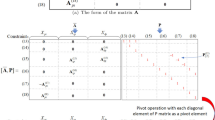Abstract
In this paper, we consider a large-scale evacuation problem after a major disaster. The evacuation is assumed to occur by means of a fleet of buses, thus leading to scheduling the evacuation operations by buses [(bus evacuation problem (BEP)]. We propose time-indexed formulations as well as heuristic algorithms such as greedy algorithms and a matheuristic. This matheuristic uses the former formulation to improve the best solution obtained by the greedy heuristics. In computational experiments, we analyze and evaluate the efficiency of the proposed solution algorithms.






Similar content being viewed by others
References
Baptiste, P., Della Croce, F., Grosso, A., & Tkindt, V. (2010). Sequencing a single machine with due dates and deadlines : An ILP-based approach. Journal of Scheduling, 13(1), 39–47.
Berghman, L., Leus, R., & Spieksma, F. (2013). Optimal solutions for a dock assignment problem with trailer transportation. In Annals of operations research. US: Springer.
Bish, D. R., Sherali, H. D., & Hobeika, A. G. (2013). Optimal evacuation planning using staging and routing. Journal of the Operational Research Society. doi:10.1057/jors.2013.3.
Bish, D. R. (2011). Planning for a bus-based evacuation. OR spectrum (pp. 629–654). Berlin: Springer.
Chamlet, L. G., Francis, R. L., & Saunders, P. B. (1982). Network models for building evacuation (Vol. 18, pp. 90–113). US: Springer.
Driebeeck, N. J. (1966). An algorithm for the solution of mixed integer programming problems. Management Science, 12, 576–587.
Della Croce, F., Grosso, A., & Salassa, F. (2011). A matheuristic approach for the two-machine total completion time flow shop problem. In Proceedings of the 11th European conference on evolutionary computation in combinatorial (pp. 38–47). Berlin: Springer.
Garey, M. R., & Johnson, D. S. (1979). Computers and Intractability: A Guide to the Theory of NP-Completeness. New York, NY: W. H. Freeman & Co. 338.
Hamacher, H. W., & Tjandra, S. A. (2001). Mathematical Modeling of Evacuation Problems: A State of The Art. In Pedestrian and Evacuation Dynamics, 1964, 227–266.
Han, L. D., & Yua, F. (2005). Evacuation modeling and operations using dynamic traffic assignment and most desirable destination approaches. In 84th annual meeting of the transportation research board. Washington, DC 05 (2401).
Kwon, E., & Pitt, S. (2005). Evaluation of emergency evacuation strategies for downtown event traffic using a dynamic network model. Journal of the Transportation Research Board, 1922, 149155.
Mahmassani, H. S. (2001). Dynamic network traffic assignment and simulation methodology in advanced system management applications. Networks and Spatial Economics, 1, 267–292.
Sattayhatewa, P., & Ran, B. (2000) Developing a dynamic traffic management model for nuclear power plant evacuation. In 79th annual meeting of the transportation research board.
Savelsberg, M. W. P. (1994). Preprocessing and probing techniques for mixed integer programming problems. ORSA Journal of Computing, 6, 445–454.
Sbayti, H., & Mahmassani, H. S. (2006). Optimal scheduling of evacuation operations. Journal of the Transportation Reasearch Board, 1964, 238–246.
Sheffi, Y., Mahmassani, H., & Powell, W. B. (1982). A transportation network evacuation model. Transportation Research Part A, 16, 209–218.
Smith, W. E. (1956). Various optimizers for single-stage production. Naval Research Logistics Quarterly, 3(1–2), 59–66.
Sousa, J. P., & Wolsey, L. A. (1992). A time indexed formulation of non-preemptive single machine scheduling problems. Mathematical Programming, 54(1–3), 353–367.
Tang, X., Soukhal, A., & T’kindt, V. (2013) Preprocessing for a map sectorization problem by means of mathematical programming. Annals of Operations Research. doi:10.1007/s10479-013-1447-8.
Van den Akker, J. M., Hurkens, C. A. J., & Savelsbergh, M. W. P. (2000). Time-indexed formulations for machine scheduling problems: Column generation. INFORMS Journal on Computing, 12(2), 111–124.
Yamada, T. (1996). A network flow approach to a city emergency evacuation planning. International Journal of Systems Science, 27, 931–936.
Zhang, X., Shi, Q., Rachel, H., & Ran, B. (2010). Network emergency evacuation modeling: A literature review. International Conference Optoelectronics and Image Processing (ICOIP), 2, 30–34.
Acknowledgments
This research has been supported by ANR-11-SECU-002-01, project DSS_EVAC_LOGISTIQUE (CSOSG 2011).
Author information
Authors and Affiliations
Corresponding author
Rights and permissions
About this article
Cite this article
Deghdak, K., T’kindt, V. & Bouquard, JL. Scheduling evacuation operations. J Sched 19, 467–478 (2016). https://doi.org/10.1007/s10951-015-0461-x
Published:
Issue Date:
DOI: https://doi.org/10.1007/s10951-015-0461-x




